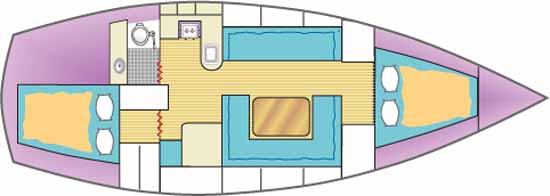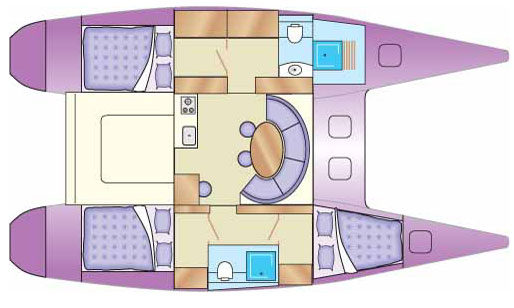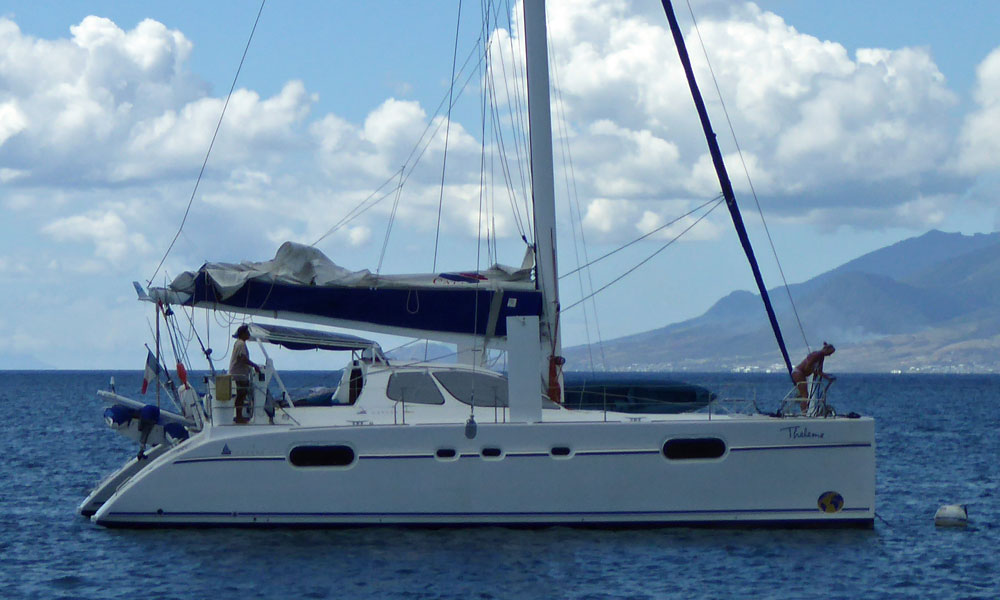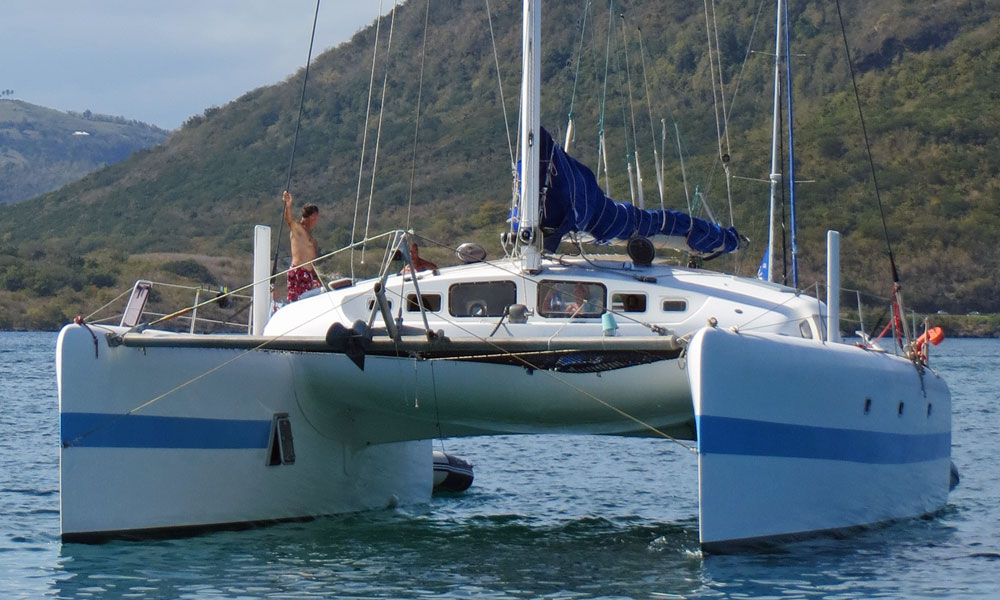- Home
- Catamaran Sail Boat
- Catamaran Vs Monohull
The Catamaran vs Monohull Argument
If there was ever an argument that could never be won it's the Catamaran vs Monohull argument.
If you're a cruising sailor you're either a catamaran man or a monohull man and no amount of rational discussion is ever going to get you to change your allegiance.
But there some indisputable facts to be recognized when comparing catamarans with monohulls.
Accommodation
A glance at the illustrations below will immediately demonstrate that the accommodation in a monohull falls far short of that available in a similarly sized catamaran.
 A typical accommodation layout in a cruising monohull of around 40 feet (12m) on deck.
A typical accommodation layout in a cruising monohull of around 40 feet (12m) on deck.Artwork by Andrew Simpson
 Additional living space created between the hulls in a similar sized cruising catamaran.
Additional living space created between the hulls in a similar sized cruising catamaran.On the downside, the twin hulls of a catamaran are considerably narrower than that of a monohull and can be claustrophobic - you'll not get the walkaround queen-sized double beds that you'll find in today's monohulls.
However, not only is the overall accommodation below deck more spacious in the catamaran, the cockpit is more spacious too - and with the cockpit and the saloon sole being on the same level, there are no companionway steps to negotiate.
If the greater level of accommodation offered by a catamaran was the deciding factor then few people would be sailing monohulls. Of course, that isn't so...
Performance
As a result of their light displacement and associated small wetted area catamarans are faster than monohulls on most points of sail. Hard on the wind though, they're at a disadvantage. Their high windage and absence of a proper keel results in greater leeway than a monohull would make, resulting in a poorer VMG (velocity made good) to windward.
However a modern cruising catamaran fitted with daggerboards, as on the Catana 47 shown below, will go a long way towards negating this deficiency.
A downside of daggerboards is that they can rattle in their housings, contributing to the general noise level of a cat slamming to windward. And slam they do, particularly those with a low bridgedeck between the hulls.
 The centreboards on this Catana 47 are in the raised position
The centreboards on this Catana 47 are in the raised positionIn recent years new hydrofoil setups and optimized daggerboard systems have been developed to boost the upwind performance of catamarans, mitigating issues like increased leeway from high windage.
Meanwhile, modern monohulls have refined their shapes and rigging systems, resulting in an aerodynamic efficiency that keeps them competitive even in challenging conditions.
Thanks to these technological improvements, both designs now offer impressive Velocity Made Good (VMG) figures. What really matters is how these enhancements translate into your cruising experience—whether you're slicing through the waves on open water or adjusting your sail plan to maximize every gust.
Comfort & Convenience
The lack of rolling and heeling is lauded by many as the primary benefit of the catamaran over the multihull - particularly so in a rolly anchorage where life aboard a catamaran is far more agreeable. Things tend to stay where they're put rather than sliding off the moment you take your eyes off them, and crew can wander around without moving from handhold to handhold.
Underway the motion of a cat is quite unlike that of a monohull, being a peculiar jerking affair which takes some getting used to.
Conversely, the more pronounced heel of a monohull offers a traditional sailing feel and can even serve as a natural mechanism to spill excess wind in gusty conditions.
Modern vessels from both camps increasingly feature digital helm stations and automated systems, ensuring that comfort, ease of use, and an overall modern feel are never in short supply.
Safety & Stability
Whilst the initial stability of a catamaran is higher than that of a monohull, once a catamaran reaches around 65 degrees or so of heel (the Angle of Vanishing Stability) it is likely to keep on going - and capsize completely.
On a properly ballasted monohull full capsize is unlikely to occur until it has heeled well past 100 degrees. Capsized, a monohull is in unstable equilibrium - it will either take on water and sink, or quickly self-right due to the motion of the sea.
But a capsized catamaran is in stable equilibrium - it will stay the wrongside up, but it's much less likely to sink. Inverted, it becomes a raft which is why you'll often find escape hatches in their hulls.
The lower initial stability of a monohull can be seen as a safety feature in a sudden gust of wind. The boat will heel and the sails will spill the wind, but that won't happen in a catamaran - the crew will need to ease the sails in a hurry.
But there's no denying that moving around on a flat cat is safer the on a heeled mono.
 The escape hatch on this cruising catamaran is partially open - it would be securely closed when underway!
The escape hatch on this cruising catamaran is partially open - it would be securely closed when underway!
Cost of Ownership
As you may expect, the two hulls and accommodation pod of a catamaran mean that its purchase price is considerably more than that of a monohull of similar length overall.
With two engines to look after, and a doubling up of many other items, maintenance costs are higher too.
And berthing costs? In a marina expect to pay double what you'd pay for a monohull of similar length overall.
Lifting out for storage ashore can be an issue too, as not all boatyards have a travel hoist capable of accommodating a catamaran.
But it's true that cats are currently commanding a higher resale value than monohulls, owing to their increasing popularity.
Monohulls typically offer a lower entry cost and simpler mechanical setups that make long-term upkeep less complicated. Yet, as both types embrace inputs like energy-efficient engines and hybrid propulsion systems, it’s important to weigh upfront expenditures against ongoing expenses.
Handling
The catamarans' high windage will work against her in close quarter manoeuvering, but her twin engines will allow a competent helmsman to deal with this easily - even turning her in her own length is possible.
To approach anything like the manoeuvrability of a catamaran, a monohull will need a bow-thruster.
Under sail, the catamaran will take longer to tack through the wind than a monohull.
Conclusion...
Ultimately, the catamaran versus monohull debate is far from one-dimensional. Each design brings its own set of advantages—from the expansive, contemporary accommodations and agile handling of a catamaran to the traditional charm and robust performance of a monohull.
Advances in technology and design continue to narrow historical gaps, ensuring that whether you choose a high-tech cat or a tried-and-tested mono, you’re investing in a vessel that’s perfectly tuned to your cruising lifestyle.
For those ready to make an informed decision, consider your personal sailing habits, the conditions you expect to face, and how modern innovations mesh with your idea of adventure. With detailed insights, expert testimonials, and interactive tools available at your fingertips, navigating this classic debate has never been easier.
So that's the catamaran vs monohull argument as I see it. I've tried not to show my bias, which is something I'm not always good at.
Cruisers' Questions...
Are catamarans better for seasickness?
Are catamarans better for seasickness?
It's generally accepted that catamarans offer a more stable experience on the water, which can significantly reduce the likelihood of seasickness compared to monohull vessels. Here's a breakdown:
Stability:
- Catamarans, with their dual-hull design, minimize the rolling motion that often triggers seasickness.
- Monohulls, on the other hand, tend to lean (heel) from side to side, which can exacerbate feelings of nausea.
Motion:
- The motion on a catamaran is typically more of a fore-and-aft (pitching) movement, rather than the side-to-side (rolling) motion of a monohull. Many people find the pitching motion more tolerable.
Overall Comfort:
- The increased stability of catamarans contributes to a more comfortable and enjoyable experience, especially for those prone to motion sickness.
However, it's important to note:
- Seasickness can still occur on a catamaran, particularly in rough sea conditions.
- Individual susceptibility to seasickness varies greatly.
In summary, while catamarans don't guarantee freedom from seasickness, their design significantly reduces the risk.
Are catamarans safe in a storm?
Are catamarans safe in a storm?
The question of catamaran safety in storms is complex, with both advantages and disadvantages to consider. Here's a breakdown based on available information:
Advantages:
Stability:
- Catamarans are known for their inherent stability, which can be a significant advantage in rough seas. Their wide beam reduces the rolling motion that can be dangerous in storms.
- This stability also reduces crew fatigue, which is a significant safety factor in prolonged storm conditions.
Buoyancy:
- Catamarans have positive buoyancy, meaning they are less likely to sink if a hull is breached. This can significantly increase crew survival chances.
Speed:
- Catamarans are generally faster than monohulls, allowing them to potentially outrun or navigate around storms.
Redundancy:
- Modern cruising catamarans typically have two engines, providing redundancy in case of engine failure.
Disadvantages:
Capsizing:
- While modern catamarans are designed to minimize the risk, they can capsize in extreme conditions. Unlike monohulls, they do not self-right.
- The way that catamarans ride on top of the waves, can in certain circumstances, make them more vulnerable to being flipped by very large breaking waves.
Maneuverability:
- In some situations, a catamaran's wider beam can make it less maneuverable in tight or challenging conditions.
Wave Action:
- Because catamarans ride on top of the waves, they are more susceptible to the impact of the waves, hitting the side of the boat, as apposed to a mono hull that cuts through the waves.
Key Considerations:
Skipper Experience:
- The skill and experience of the skipper are paramount in any storm situation, regardless of the vessel.
Modern Design:
- Modern catamarans are designed with safety in mind, incorporating features that enhance their seaworthiness.
Weather Forecasting:
Modern weather forecasting allows sailors to anticipate and avoid severe weather conditions.
In conclusion:
- Catamarans can be safe in storms, but they require careful handling and a knowledgeable crew.
- Modern designs and technology have significantly improved their safety record.
- It is very important to respect the power of the sea, in any vessel.
Can a catamaran heave to?
Can a catamaran heave to?
The concept of "heaving to" is traditionally associated with monohull sailboats. However, catamarans can achieve a similar state, though the technique and resulting behavior differ. Here's a breakdown:
Understanding Heaving To:
- In a monohull, heaving to involves balancing the sails and rudder to create a relatively stationary position, typically with the bow angled to the wind and minimal forward movement.
- This is useful for weathering storms, taking breaks, or making repairs.
Catamarans and Heaving To:
- Catamarans, due to their design, behave differently. They don't typically "heave to" in the same way as monohulls.
- However, they can achieve a relatively stable position in rough conditions.
- Key differences:
- Catamarans tend to drift more to leeward than monohulls when attempting to "heave to."
- The technique involves finding a balance between sail trim and rudder position to minimize motion and maintain a comfortable angle to the waves.
- It is very important to understand that the way a catamaran reacts to large waves, is very different to that of a mono hull.
- Instead of a complete stop, catamarans often achieve a slow, controlled drift.
Factors to Consider:
- Catamaran design varies, and the ability to achieve a stable position depends on the specific vessel.
- Sea conditions play a significant role.
- Skipper experience is crucial for finding the optimal balance.
In summary:
- While catamarans don't "heave to" in the traditional monohull sense, they can achieve a stable position in rough weather.
- The technique involves different sail and rudder adjustments, resulting in a slow drift rather than a complete stop.
- It is very important to understand the different behaviour of a catamaran, compared to a mono hull, in heavy weather.
Why do sailing catamarans have trampolines?
Why do sailing catamarans have trampolines?
Sailing catamaran trampolines serve several important functions, blending practicality with comfort:
Weight Reduction and Performance:
- Replacing a solid deck with a trampoline significantly reduces the vessel's overall weight. This weight reduction contributes to improved sailing performance, allowing the catamaran to move faster and more efficiently.
Drainage:
- The open weave of a trampoline allows water to drain quickly, preventing pooling on the deck. This is particularly important in rough seas, where waves can wash over the bow. Proper drainage helps maintain stability and reduces the risk of the bow becoming submerged.
Increased Deck Space:
- Trampolines provide a large, flexible area for crew and passengers to move around, relax, and enjoy the sailing experience. This additional space is valuable for lounging, sunbathing, and socializing.
Structural Integrity:
- In some catamaran designs, the trampoline also contributes to the structural integrity of the vessel, adding tension and support between the hulls.
Safety:
- They provide a safe area to work on the forward part of the boat, when dealing with sails, anchors, and other forward equipment.
- They also provide a less solid surface that can help to absorb some of the impacts of waves.
In essence, catamaran trampolines are a clever design feature that maximizes space, minimizes weight, and enhances the overall sailing experience.
Recent Articles
-
Albin Ballad Sailboat: Specs, Design, & Sailing Characteristics
Jul 09, 25 05:03 PM
Explore the Albin Ballad 30: detailed specs, design, sailing characteristics, and why this Swedish classic is a popular cruiser-racer. -
The Hinckley 48 Sailboat
Jul 09, 25 02:44 PM
Sailing characteristics & performance predictions, pics, specifications, dimensions and those all-important design ratios for the Hinckley 48 sailboat... -
The Hinckley Souwester 42 Sailboat
Jul 09, 25 02:05 PM
Sailing characteristics and performance predictions, pics, specifications, dimensions and those all-important design ratios for the Hinckley Souwester 42 sailboat...












